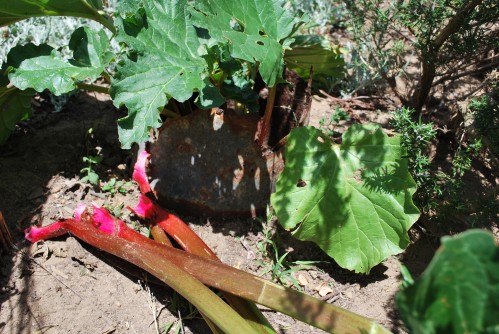Rhubarb Rules
 Not everyone loves rhubarb. It seems like there are two types of people in this world. Those who love rhubarb, and those who don't. I fall into the category of loving rhubarb. I look forward to baking with it in the spring, picked fresh from my garden. I keep it in a tucked away place and basically just let it be. When I initially planted my rhubarb plant two seasons ago, I put a bottomless vintage pail over it to force it's desired stalks to grow straight and long. It worked.
Not everyone loves rhubarb. It seems like there are two types of people in this world. Those who love rhubarb, and those who don't. I fall into the category of loving rhubarb. I look forward to baking with it in the spring, picked fresh from my garden. I keep it in a tucked away place and basically just let it be. When I initially planted my rhubarb plant two seasons ago, I put a bottomless vintage pail over it to force it's desired stalks to grow straight and long. It worked.
For those who love rhubarb, you probably know quite a bit about it. It is often found cleaned and bundled at our local stores in the produce section, and farmers markets spring time into summer. For those who love rhubarb, it is always a treat to find it fresh, as it does have a short harvest season.
If you are planning on planting a perennial rhubarb plant in your garden, keep in mind, it takes about two years for your plant to be harvest-ready. A rhubarb plant likes full sun, acidic soil, and moderate water. Mulch it well in the spring and fall. Three to four rhubarb plants will suffice for a family's needs.
In spring, choose long, crisp-looking stalks from your plant. Gently pull at the bottom of each stalk to harvest, rather then cutting it from the plant crown. Harvest stalks carefully, leaving at least 1/3 of your original plant. Rhubarb plant crowns can be carefully divided with a shovel when they become too large.
Rhubarb stalks can be kept fresh in a refrigerator, preferably unwashed for about a week, and also can be cleaned, diced, and kept frozen in your freezer. Do not eat rhubarb leaves, as they are poisonous.
I thought maybe I could "dig up" some new facts about rhubarb you might not know.
Rhubarb is a vegetable, and not a fruit.
Rhubarb is related to Sorrel.
Rhubarb is usually cooked first before adding to recipes, due to its intense tartness, and fibrous stalk structure.
Rhubarb plants are long lived, and can be productive for a life time.
Rhubarb pairs well with citrus fruits like oranges and grapefruit.
Rhubarb as a savory, pairs well with meat stews, and legumes like lentils.
Rhubarb has a highly acidic property which reacts to baking soda in a magical way, creating amazing baked goods.
Rhubarb varieties come in green, pink, and red colors.
Rhubarb comes in purely ornamental varieties, too, so look to see if your rhubarb plant is edible or ornamental.
Rhubarb is an incredible plant. Tuck it way in a quiet sunny spot, or boldly plant it as a foundation plant in your garden. It is a low maintenance plant, pest and disease-resistant.
It's tart taste easily transforms into sweets, savories, baked goods, syrups, sauces, drinks, and jams. In fact each spring, I anxiously anticipate from "cooking circles" what is this year's newly creative way to use rhubarb. Please share if you have rhubarb plants in your garden. Please comment on how you like to cook or bake with rhubarb.
VintageGardenGal Tidbit Thyme....
A fabulous facial is just as important to a "gardener gal" as her gloves, and favorite hoe. For those that live in the San Diego area, treat yourself to Orgin Day Spa. First time clients, mentioning VintageGardenGal, are entitled to 20% off a facial. I love their "Signature Facial." Treat yourself, and start your summer right!
